Meghalaya, a lovely state in northeastern India, is known for its lush scenery, breathtaking waterfalls, deep forests, vibrant culture, and rolling hills. It is one of the Seven Sisters states, bordering Bangladesh to the south and Assam to the north.
Meghalaya is also known for its abundant rainfall, it is home to places like Cherrapunji and Mawsynram, which are among the wettest places on Earth and which of these are the Best Time to Visit Meghalaya- Winter (October to March), Summer (April to June) or Monsoon (June to September)?
It is home to an abundance of indigenous tribes, such as Khasi, Jaintia, and Garo, each having its own language, festivals, and traditions. Nokrek National Park and Balpakram National Park are key wildlife sanctuaries. The state has a diverse range of wildlife, such as elephants, tigers, and other bird species, as well as bamboo forests and orchid gardens.
Table of Contents
Tourist attractions: (Best Time to Visit Meghalaya)
1. Living Root Bridges
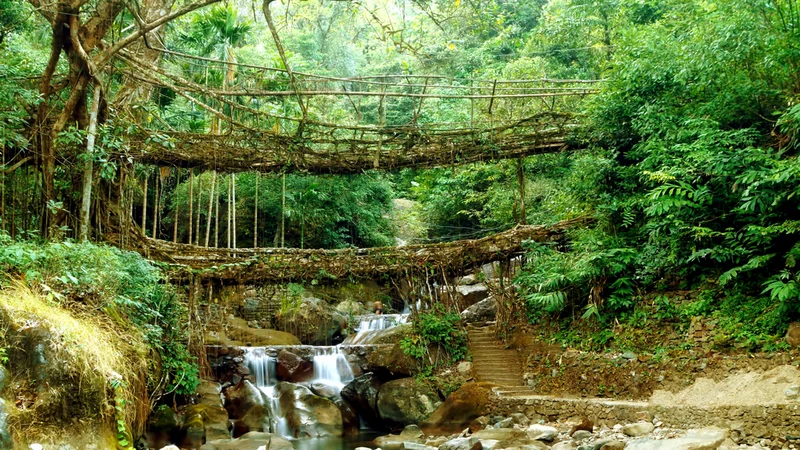
The Living Root Bridges are a unique form of bridges made from the roots of rubber trees, grown and shaped over years by the local Khasi and Jaintia tribes. These living bridges are mostly found in moist, forested areas of Meghalaya, and are renowned for their strength and capacity to endure heavy rainfall.
Some of the most famous Living Root Bridges are those in Cherrapunji and Mawlynnong, which have become popular eco-tourism sites because of their amazing craftsmanship and natural beauty.
2. Nohkalikai Falls (Best Time to Visit Meghalaya)
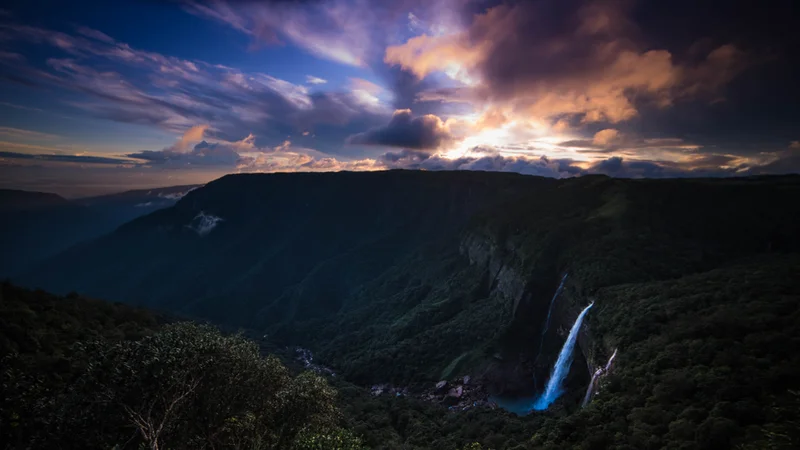
Nohkalikai Falls, one of India’s tallest waterfalls (1,100 feet), is located near Cherrapunji. The waterfall cascades from a cliff, forming a stunning green pool below. The waterfalls are surrounded by thick greenery and are especially beautiful during the rainy season. The name “Nohkalikai” translates as “Jump of Likai,” and refers to a tragic local legend about a woman named Likai who is associated with the waterfall.
3. Elephant Falls
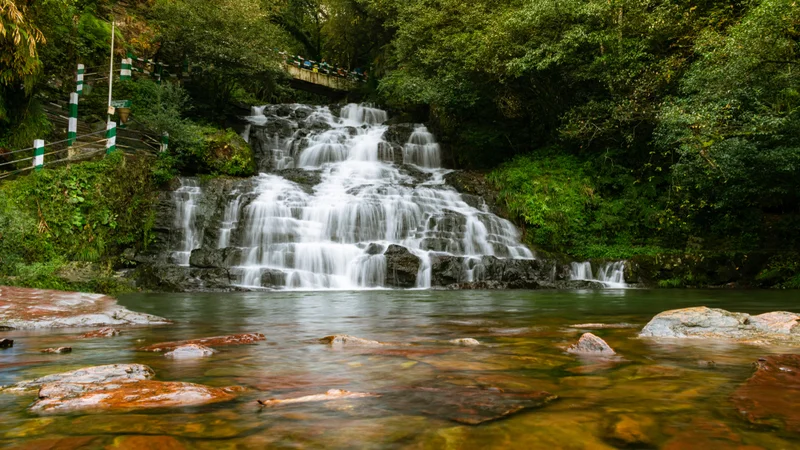
Elephant Falls: A waterfall rises from the higher level and flows downstream, forming the Elephant Falls. These falls are 12 km away from Shillong. The British named it ‘Elephant Falls,’ a direct result of a stone that takes after an elephant close to the falls, and the water falls in three stages. It was destroyed by an earthquake in the 19th century, but the name hasn’t changed. The first fall is wide and covered up between trees.
In the winter, when the water level drops, the second fall is limited and meaningless. The last and the third cascade is the tallest. Elephant Falls is described as clear water streaming over dark, clinging rocks with no visible structures. The best time to visit is during the monsoon season when the falls are at their fullest. The cool, foggy weather in winter also makes it a refreshing destination.
4. Mawlynnong
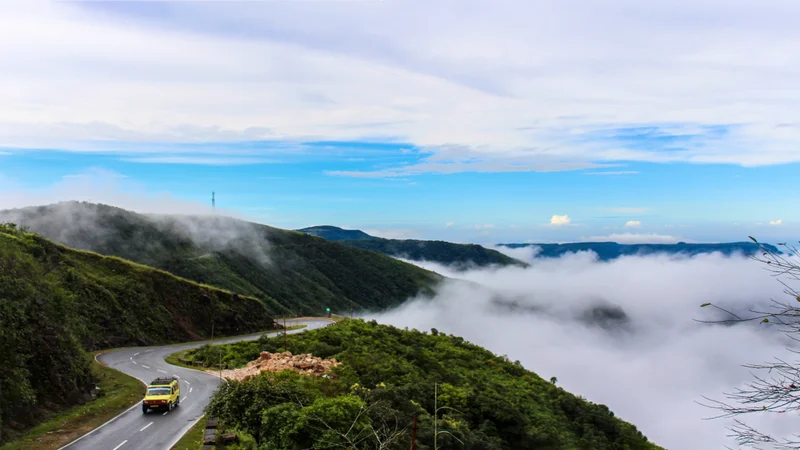
Mawlynnong, sometimes known as “Asia’s Cleanest Village,” is a peaceful and charming village in the East Khasi Hills. The village is renowned for its clean environment, which is maintained by people who live there. Mawlynnong offers visitors a glimpse of the traditional lifestyle of the Khasi people, as well as breathtaking views of the surrounding landscape. The village also boasts a living root bridge and a viewpoint offering sweeping views of Bangladesh across the border.
5. Dawki
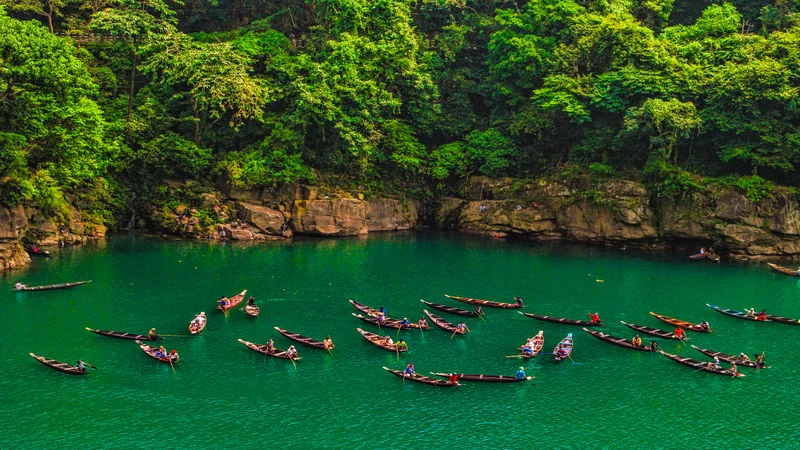
Dawki, located near the Bangladesh border, is famous for its crystal-clear river, the Umngot River. The river’s transparent waters make it a unique spot for boating, as the boats seem to float above the riverbed. Dawki is especially recognized for its gorgeous surroundings, making it a popular destination among people looking for natural beauty and adventure. The Dawki Bridge, a century-old structure, is another highlight of this lovely region.
Adventure: (Best Time to Visit Meghalaya)
Trekking: Popular trails are the David Scott Trail and the Nongriat Trek (to observe the root bridges).
Caving: Meghalaya has various caves, including Siju, Liat Prah, and Mawsmai, which attract cave lovers.
The best time to visit meghalaya is depends on the experience you’re looking for, as the state offers different charms in different seasons. Here is a detailed explanation.
Best Time to Visit Meghalaya are:
1. Winter (October to March)
The winter season in Meghalaya lasts from October to March. The temperature will be approx. 10°C to 20°C (50°F to 68°F), ideal for outdoor activities. During this time, the skies are often clear, offering amazing views of the hills, valleys, and waterfalls; the weather is cool, clear, and perfect for sightseeing and trekking.
During October and November, various local festivals take place, such as the Nongkrem Dance Festival and the Wangala Festival. These cultural festivals offer a unique glimpse into the diverse traditions of the state.
It’s ideal for exploring sites such as the David Scott Trail and Nongriat. The temperatures are cooler, making it easier to enjoy the beautiful green scenery and waterfalls, and the weather is more favorable for outdoor activities.
The clean skies and lovely sunlight make it an ideal time to capture the landscapes of Meghalaya. It is one of the best seasons to discover the natural beauty and scenery of this state.
2. Summer (April to June) (Best Time to Visit Meghalaya)
Summer is the best Time to Visit Meghalaya, especially if you enjoy cool temperatures, which range from 20°C to 30°C (68°F to 86°F). Meghalaya is normally cooler than the rest of India due to its high altitude and rocky terrain, making it an excellent spot to relax from the heat of the plains.
The sunny weather is ideal for exploring popular destinations such as Cherrapunji, Mawlynnong (Asia’s cleanest hamlet), Living Root Bridges, Nohkalikai Waterfall, Elephant Falls, and more.
The waterfalls are stunning throughout the year, but the dry season means they are less likely to be flooded by rain, making them simpler to reach.
The highways and trekking routes are more accessible because the summer receives less rainfall than the monsoon season. If you’re coming from a warmer climate, Meghalaya’s temps will feel refreshing.
3. Monsoon (June to September)
The monsoon season in Meghalaya may be intense, with temperatures between 18°C and 25°C (64°F and 77°F), but the region receives significant amounts of rainfall, particularly in areas such as Cherrapunji (which has the greatest annual rainfall in India) and Mawsynram. During this period, the state is lush, chilly, and green, but it also presents challenges.
The state is at its most colorful form during this season, with cascading waterfalls, verdant forests, and beautiful green landscapes. If you cherish the greenery of nature, this is the time to experience it.
You will find less people at major attractions because it is the off-season for travelers. If you prefer privacy and wish to avoid the crowds, this could be an excellent time for you to have a more personal experience with Meghalaya’s natural beauty.
CHALLENGES: (Best Time to Visit Meghalaya)
- Heavy rains can produce flooding and landslides, making roadways difficult to navigate. Some trekking trails may be closed due to excessive rainfall.
- The humidity is higher during the monsoon season, which might make the weather uncomfortable for travelers who are not used to it.
- Some regions, especially more rural towns and trekking routes, may be difficult to access during the rainy season due to poor road conditions.
If you enjoy lush landscapes and don’t mind the rain, the monsoon season provides breathtaking beauty. You can see the waterfalls at their peak, and the vegetation is luxurious.
Additional Tips: (meghalaya best time to visit)
- Cherrapunji and Mawsynram: These places are known for their heavy rainfall, so it’s better to visit them in the dry months (October to March) unless you specifically want to experience the monsoon.
- Shillong: The capital city of Meghalaya is a year-round destination with a pleasant climate throughout the year. In winter, it can get chilly, so carrying warm clothing is a good idea.
CONCLUSION
Meghalaya is a year-round destination that uniquely blends its natural beauty, rich cultural past, and adventurous activities. The state has something for everyone. The months of October to March are great for enjoying the chilly, crisp weather. This is an ideal time for sightseeing, trekking, and enjoying the breathtaking natural beauty of the state, without the hassle of heavy rain or the harsh cold of winter in higher areas.
The summer season (April to June) is the best time to Visit Meghalaya for those who prefer cooler weather. The weather is still pleasant, and you can explore the state.
If you enjoy the rain and are willing to enjoy the monsoon season’s lush, green landscapes, July to September has some beauty, but be prepared for possible travel delays and difficult conditions due to the heavy rain.
FOR MORE TRAVEL BLOG VISIT @lgstravellers
FAQs
When is the best time to visit Meghalaya for sightseeing?
The ideal months for sightseeing are October to March. During this time, the weather is cold, dry, and comfortable, making it excellent for exploring the natural beauty of the state and tourism destinations such as Cherrapunji, Mawlynnong, and Living Root Bridge.
Can I visit Meghalaya during the summer?
Summer is a lovely season to visit because the temperatures are pleasant, ranging between 20°C and 30°C (68°F to 86°F), providing relief from the heat on the plains. This is a great time to go sightseeing and enjoy outdoor activities in places like Shillong and Tura.
Is it safe to travel to Meghalaya during the monsoon season?
Traveling to Meghalaya is not recommended during the monsoon season because the state receives heavy rainfall that can produce flooding, landslides, and unsafe trekking routes.If you enjoy greenery and don’t mind rain, you can visit areas like Cherrapunji and Mawsynram, but be prepared for travel delays.
What is the best time to visit Meghalaya for trekking and adventure activities?
The ideal months for trekking and adventure activities like as hiking, camping, and caving are October to March. The temperature is cool, making it excellent for visiting Meghalaya’s many trekking trails, such as those in Dawki, Mawphlang, and the Nongriat Village.
How should I prepare for a visit to Meghalaya during the monsoon season?
If you are visiting during the rainy season, make sure to:
1. Bring waterproof clothes such as raincoats, umbrellas, and shoes.
2. Check the weather frequently and plan your travel accordingly.
3. Avoid distant places that may be at risk of landslides.
4. Keep an eye on the road conditions, since heavy rain may create delays.
Does Meghalaya get snow in winter?
Meghalaya doesn’t normally receive snow, but some higher-altitude areas, such as Mawphlang, Shillong Peak, or Tura Peak, can get fairly cold in the winter, with a light frost in some places. However, snowfall is rare.